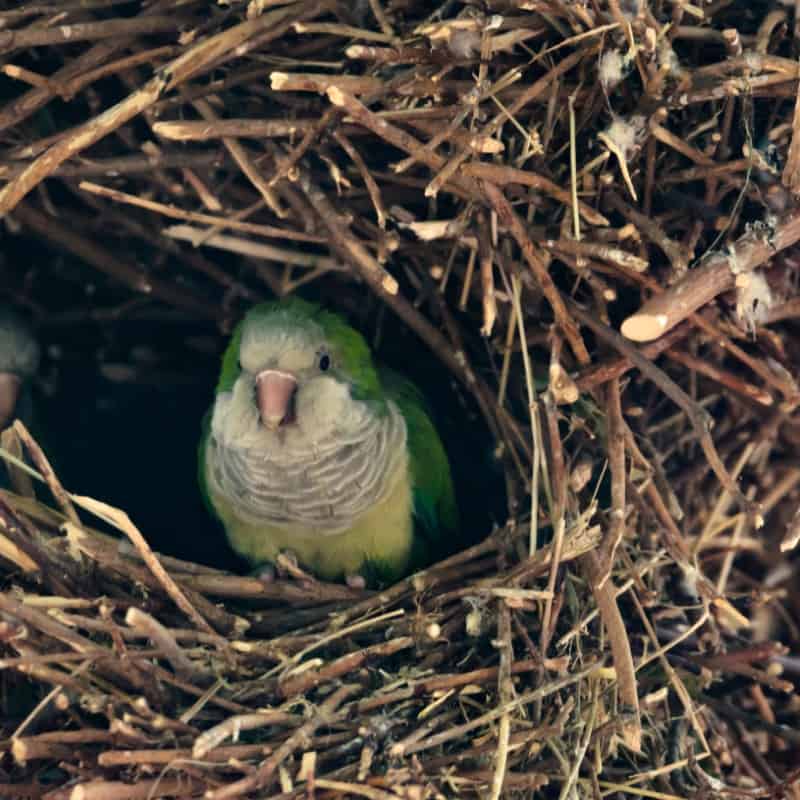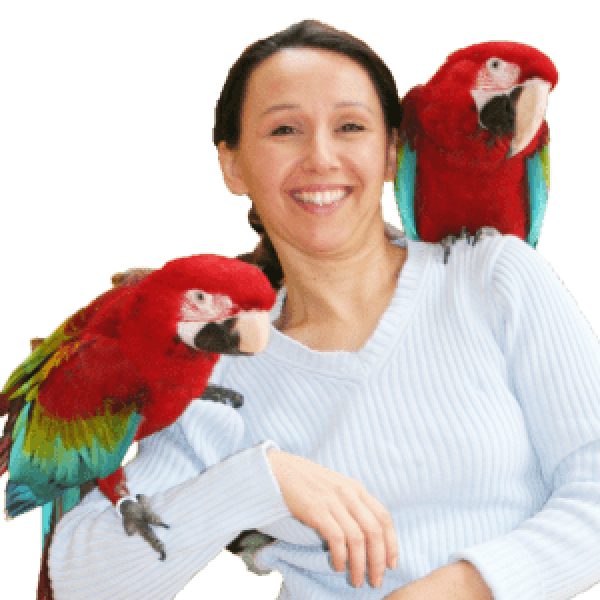Last Updated on by Catherine Tobsing
File under “the universe is too complicated to be arbitrary” which begs the question “does a dyslexic agnostic believe in dog?”
From our Birdie Bruch reader Betsy L.
THANK YOU for today’s (9/11/2016) birdy brunch! It was perfectly timed…
Yesterday evening, a Quaker parrot landed on my friend’s head while he was out on his deck (near Lawrence and Kedzie in Chicago).
I took the bird in overnight and am trying to find its owner (it’s not wild).
Editor’s note: Chicago has a huge population of Quaker parrots that live on the south side around Chicago’s Hyde Park neighborhood.
They live there year-round and can survive Chicago winters by building huge colonial nests where the entire flock keeps itself warm.
Because they have been in Chicago for so many years, they are probably one of the more “social” wild birds in the area.
To say that this particular bird is not wild is only a WAG (Wild Ass Guess)
I’ve used the links in your post, as well as spreading the word on FB and among my bird-rescue friends.
We can’t keep this guy (already have one bird in quarantine–now two–and a hubby recovering from pretty major spine surgery), so hopefully his rightful owner will surface soon.
Just wanted to say thanks!
Hey Betsy
That’s CRAZY in a good way – best of luck – shoot us a picture and contact info and we’ll post them on social rescue platforms.
Thank you!
Hi Mitch
The bird is currently being fostered, and I’ve asked the foster “mom” for contact info.
In the meantime, here are a few pics of the little guy. He landed on my (male) friend’s head in the 4900 block of N Francisco last Saturday late afternoon.
He ate peanuts off his head and then rode around on his shoulder for a while (which is how they got him inside and into a cage).
He was stressed but seemed healthy and really acted like someone’s pet bird as opposed to a wild one.
Hi again!
Kathy at Happe Parrots Rescue helped me with this situation.
She has the contact info for the foster and is happy to talk to you if you have a minute. (I asked her for contact info to send to you directly, but I think she was more comfortable doing it this way.)
I really hope we can find this guy a good home soon.
Seems like a nice bird!
Thanks again for all the great tips in the last Birdy Brunch!!!
Thank you for a great opening act Betsy
Geek warning
Whether it’s a child learning to tie its shoes or a pilot studying how to fly a 747 the four stages of learning are the same.
1) unconscious incompetency – you don’t know what you don’t know – as in “We’re going to teach you how to tie your shoes today Susie”.
2) which now makes Susie a conscious incompetent – she now knows that she doesn’t know how to tie shoes.
3) the next step is conscious competency – you’re able to accomplish a task but you need to think about each step – “put one lace over the other – create two loops – one loop under another and pull it tight”.
4) unconscious competency is you, driving a car – you’re thinking about where you have to be – paying bills – where the kids are – you’re not thinking about the mechanics of driving – they are being taken care of at some other part of your brain.
You bring a new bird home – it’s always been in a cage.
“Golly, it would be fun to see the bird fly”.
The bird flies out the moment the bird cage door opens and flies into a wall not hurting himself but you say “They were right on the Internet, you should not let your birds fly in the home because they will fly into a wall or a mirror.”
“Have you given this much thought Martha”?
I imagine most of you reading this drive terrestrial vehicles.
There are probably some aspiring drivers out there as well.
Let’s go back to that day when you got your learner’s permit and dad took you out to the big parking lot.
You get the seat adjusted – the mirrors, the seat belt.
Foot on brake – put the car into drive – hands at two and ten – accelerate slowly.
Dad calmly says “Let’s try a stop.”
You did and somehow the airbags didn’t deploy when the two of you were thrown toward the windshield due to Newton’s third law of physics (Google it)
This is when Dad said “See this will never work out, you will never drive, get out let me drive home” and called it a day.
Even if you went solo, you found yourself maybe coming too close to another car or making a turn too fast.
It took a number of miles over a number of months or years before you were fully comfortable driving.
There is and always will be the debate between clipping birds’ wings and allowing birds to be flighted.
We are advocates for flighted birds BUT it’s not that simple.
Parrots in the wild can fly dozens if not 100 miles or more each day seeking food.
Recently a self-driving Tesla rear-ended a truck killing a person.
At the time the vehicle relied on cameras for positioning around other vehicles.
The forensic investigation discovered that it was a very bright day and the truck was white.
The self-driving car’s computer decided the white truck was the sky.
Tesla has since installed radar in self-driving cars as an added level of safety.
So here’s a hypothetical.
Your bird flies across a room for the very first time and flies into a wall?
Is it possible for the bird to know the difference between the wall and a cloud or the sky?
In most cases, this is due to “panic flight”.
Birds don’t know what glass is.
A male canary will defend the other male canary in the mirror until it drops – which is why you don’t put mirrors in canary cages.
We were going to work with Bacon (our first budgie) the way we started with our cockatiel Popcorn – who flew into a wall and landed behind a dresser less than an hour of being in our home.
We clipped Bacon’s wings.
This accomplished a couple of things.
The bird’s confidence level got reduced – a good thing in this case because it’s only temporary and the chance of flying into a window or a wall has been diminished.
That said don’t ever think for a minute a clipped bird cannot fly – you’ve been warned.
Next, we tried to determine how much lift she had, out of the birdcage.
Turns out that she had enough lift to zero in on a window in a room whose door was open that shouldn’t have been.
Bacon flew right into it, fortunately not sustaining any injury whatsoever.
We could tell by her demeanor that she was not going to be a happy bird by herself and she’d be damned if she couldn’t fly.
We relegated her to a nice-sized birdcage and then rescued our second budgie, Eggs.
Within two or three days we had two very happy birds in a cage.
So what are we going to do about teaching our birds to fly?
Fast forward to November 2018 where we now have 10 budgies.
All are flighted and they will remain in what is now a very large aviary.
They are able to fly across it and hover in the middle, giving them plenty of exercise and things to do.
Circling back to the theme of this post “learning to fly,” it’s really a nonstarter.
We don’t need to teach our birds how to fly, they’ve known that for 100 million years.
We need to teach them how and where to land within our home.
This gives them confidence and helps them feel more secure while engaging their human flock.

If a bird flies into a room and has no place to land it may fly back out, hopefully to its home cage. Birds should not have to deal with that indecision. It’s important for them to feel confident flying into a room having a place specifically for them to land.
We provide bird play stands in all the rooms that we want our birds to reside in with us.
This way they can choose to engage with us comfortably or seek solace within a birdcage of their own.
By providing your bird this provision they are less likely to bite as an impulse reaction (flight or bite).
Less reason for your captive bird to display any unhappiness with his or her current environment.
This all comes down to allowing our birds to act like birds without forcing our views on how the animal should comply with our version of domestication.
The more you try to alter your bird’s hundred million-plus years of instinctual expectations, the more likely to see your bird simply push back or be miserable.
Keto, our ringneck now has access to the complete living room and dining room.
He likes to visit the budgies.
He also is allowed in the master bedroom.
There is a play stand on a table with its own LED light but he prefers the top of my recliner.
A white towel is always on top so cleanup is easy.
This took about six weeks to set everything up in our home.
We feel his complete integration into the household will take at least a year for him to know the nuances of the layout, and where he lives, and can go and land without being harassed.
Written by Mitch Rezman
Approved by Catherine Tobsing
Author Profile
Latest entries
 The Traveling BirdJune 26, 2025Can You Name 5 Parrot Species That Are Living Wild in the USA?
The Traveling BirdJune 26, 2025Can You Name 5 Parrot Species That Are Living Wild in the USA? Bird BehaviorJune 26, 2025How is it Parrots Are Problem Solvers Social Animals and Even Use Tools?
Bird BehaviorJune 26, 2025How is it Parrots Are Problem Solvers Social Animals and Even Use Tools? Bird & Parrot AnatomyJune 25, 2025How a Tiny Chemical Modification Makes Parrots Nature’s Living Paintings
Bird & Parrot AnatomyJune 25, 2025How a Tiny Chemical Modification Makes Parrots Nature’s Living Paintings PigeonsJune 20, 2025How Do Parrots Thrive in Cities Outside Their Native Habitats?
PigeonsJune 20, 2025How Do Parrots Thrive in Cities Outside Their Native Habitats?





Debi Schwartz
26 Nov 2023I had one budgie who died flying into a wall, and a second one who died flying into the side of a six foot long walk-in flight (I took him to a vet for a necropsy). That said, I have had two conures who have free flown around the house for years and never had a problem. Buddy, my Jenday, was 29 when he died, Echo, the sun, is 13 and still going strong. She shares a cage with a 35 year old blue front amazon (her choice, not mine) . I’ve had the amazon 30 years and she prefers climbing and doesn’t fly.